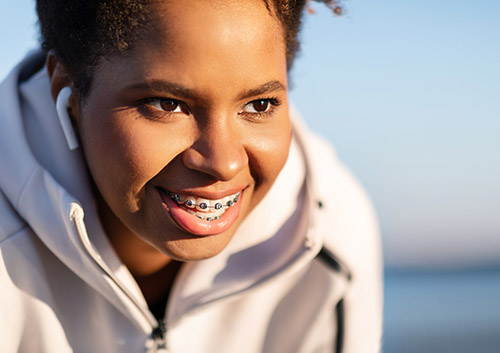
Orthodontists and dentists use advanced procedures to treat and save teeth. But sometimes, a tooth just can’t be saved and needs to be extracted. Sometimes it’s due to extensive decay, or infection, or serious injury. Or sometimes, to create a healthy bite, an extraction is necessary during orthodontic treatment.
When does an orthodontist recommend an extraction? Conditions which call for extraction include:
Not many people have enough space in their mouths for four wisdom teeth! And when there’s no room to erupt properly, wisdom teeth can become decayed or infected, push your other teeth out of place, and damage the roots of nearby molars. Extracting wisdom teeth protects your teeth and your bite alignment.
Usually, orthodontic treatment takes place before the wisdom teeth begin to erupt. But if yours start to make an appearance during treatment, your orthodontist and dentist will work together to schedule extraction without interfering too much with your orthodontic treatment plan.
Dr. Curtis N. Kamisugi and the team at Kamisugi Orthodontics carefully plan your treatment based on examinations, X-rays, and/or 3D imaging. The goal is to align your teeth and jaws for an attractive smile and a healthy, functional bite. When overcrowding is severe, or if there is a serious malocclusion (bite problem), or if a particular tooth is unusually large or misshapen, your orthodontist might recommend an extraction.
Sometimes more room can be made for teeth with appliances such as palatal expanders or, in other cases, with the help of oral surgery. Extractions are only recommended when they are absolutely necessary.
Baby teeth normally fall out in a predictable pattern. Front teeth first, canines and molars last. Baby teeth have small roots, and these roots begin to break down when the adult teeth underneath put pressure on them as they start to erupt. As the root gets smaller and smaller, the baby tooth gets looser and looser—until it falls out.
Sometimes, though, the roots of primary teeth don’t break down, and the baby teeth stay right where they are. This means that the permanent teeth have to erupt someplace else—usually behind those baby teeth. This creates a double row of teeth, and your permanent teeth can become crooked or overlap as they try to fit in. Extracting stubborn baby teeth allows your adult teeth to come in just where they’re supposed to. Because of their small roots, extracting primary teeth is usually simple and straightforward, and can be done in your dentist’s office.
Most of us have 32 adult teeth, including wisdom teeth. It’s rare, but sometimes an extra, or supernumerary, tooth develops. Your jaw is most probably not equipped to accommodate any extras, so, in this case, the extra tooth or teeth are removed to give the rest of the teeth the space they need to avoid overlapping or crowding.
When your orthodontist recommends an extraction, it’s because it’s important for your dental health. Dr. Curtis N. Kamisugi will refer you to a dentist or a specialist like a periodontist or oral surgeon, who will:
Extraction is never your first choice, or your orthodontist’s! But when an extraction is necessary for tooth and bite alignment, everyone at Kamisugi Orthodontics in Aiea, Hawaii will coordinate a treatment plan to create your best—and healthiest—smile.

How long? Well, a beautiful smile is both science and art—proper teeth and jaw alignment united with aesthetically pleasing results. Orthodontists achieve both these outcomes with a careful analysis of any dental and facial problems, a treatment plan designed specifically for each patient’s needs, and adjustments through each phase of treatment to carefully bring about that beautiful smile.
And that’s a long way of saying, there’s no one, standard answer as to how long a patient will wear braces because there is no one, standard patient. Often, treatment takes from 18 to 24 months, but it can be months shorter or months longer depending on a variety of different circumstances.
Your orthodontic needs and goals will generally determine your treatment time. Some patients need only a bit of alignment, which can lead to a fairly short orthodontic experience. Some have malocclusions such as crossbites and open bites that require more complex and lengthy treatment.
And, while we used to think of orthodontics as a teenage rite of passage, that’s certainly no longer the case. Some children will need two-phase orthodontic treatment, where early procedures before the adult teeth even come in ease the way for any necessary second stage treatment when the permanent teeth arrive years later. And some adults will want orthodontic work later in life, where denser bone tissue might lead to (somewhat) longer treatment.
Today’s orthodontics offers you many choices in appliances. Lingual braces are an almost invisible option, with brackets and wires on the inside of the teeth. Aligners use clear, custom molded trays to move the teeth into a better position with each new tray. Even traditional braces are smaller and sleeker today, with metal or less visible ceramic brackets. Depending on the orthodontic goals you want to achieve, there might be a small difference in the amount of time each appliance will take to get you to those goals. Talk to us about all your options and what they mean for treatment time.
This is one area you can make a real difference! If you follow our instructions for using your appliances most effectively, you’ll make progress as quickly as possible. If you have aligner trays, be sure to wear them for as long as directed each day. If you have rubber bands attached to brackets on your upper and lower teeth, wear them for as many hours as required, because these little bands are actually the tools that are moving your teeth into alignment. If you don’t wear your braces or aligners as directed, not much is going to happen, and certainly not on schedule.
Give our Aiea, Hawaii office a call, and we can discuss your goals for creating your very best smile. Once we’ve decided on a treatment plan, Dr. Curtis N. Kamisugi can give you a fairly good estimate as to how long your particular treatment will take. And, when you get to share that beautiful, healthy smile, the time you’ve spent achieving it will be well worth it!

You and your braces will become good friends over the coming months or years, so it’s important to get your relationship off to a good start. Consider the following recommendations to prevent rocky times ahead:

People have been ushering in the New Year for centuries but it became an official holiday in 1582 when Pope George XIII declared January 1st to be the day on which everyone would celebrate the New Year. At midnight people would yell, holler, and blow horns to scare away the evil spirits of the previous year so the New Year would be joyous and filled with opportunity. Nearly 500 years later, we still greet the New Year by whooping and hollering, but in a celebratory manner instead. Whether you intend to ring in the New Year quietly at home in the Aiea, Hawaii area or have plans to join the countdown at a gala extravaganza, these tips can help you ring out the old and usher in the new with a smile.
Tips for a Happy New Year’s Eve Celebration from Kamisugi Orthodontics
New Year’s Eve is a time to gather with friends and family, reflect on the year that’s coming to an end, and look forward to the new one with anticipation. Enjoy this transitional holiday in a way that’s safe, healthy, and fun. After all, counting down until the clock strikes 12 marks the beginning of a full year of opportunity ahead of you. From Dr. Curtis N. Kamisugi, have a great new year!.